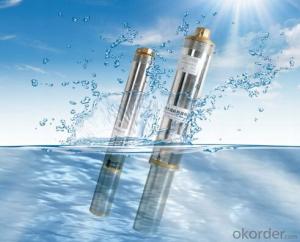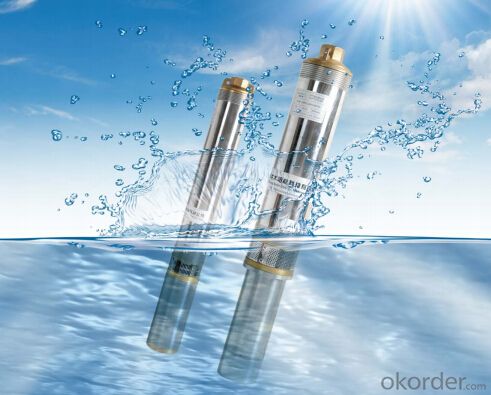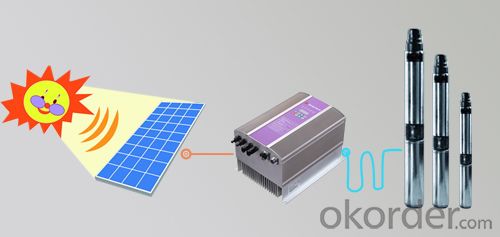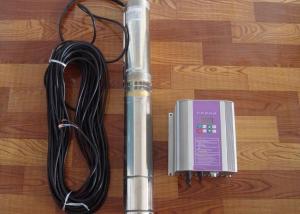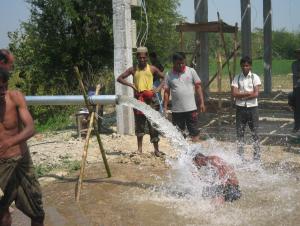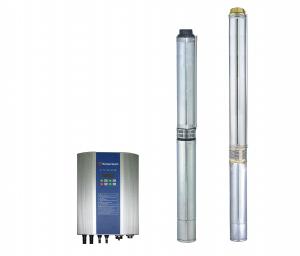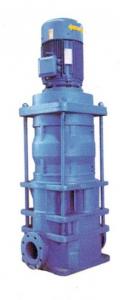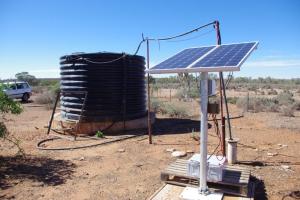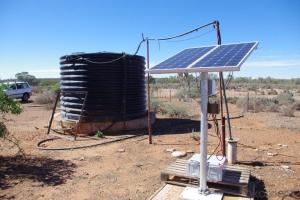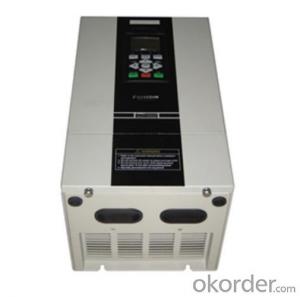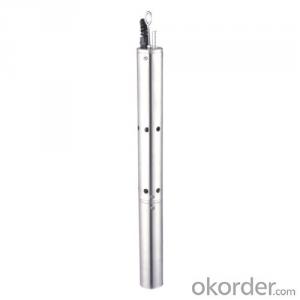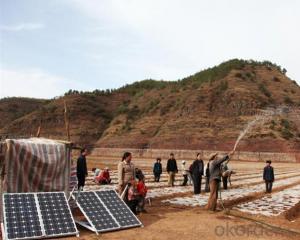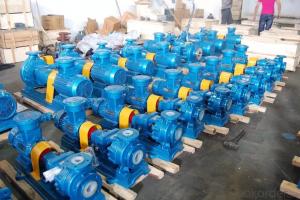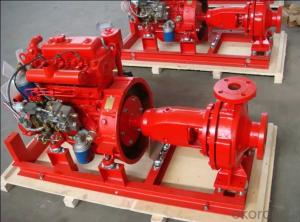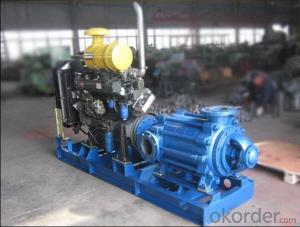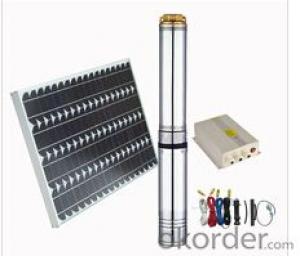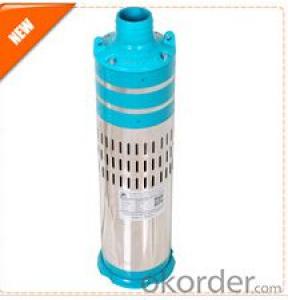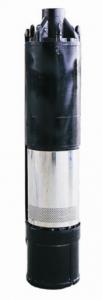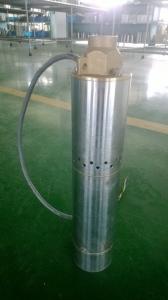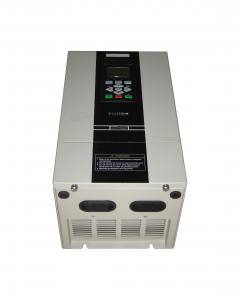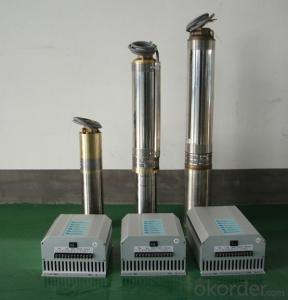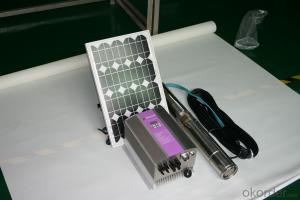Outdoor Solar Water Pump - Centrifugal Pump System 0.65kW for Agricultural Irrigation
- Loading Port:
- Shanghai
- Payment Terms:
- TT OR LC
- Min Order Qty:
- 10 pc
- Supply Capability:
- 1000 pc/month
OKorder Service Pledge
OKorder Financial Service
You Might Also Like
Solar Water Pump Centrifugal Pump System 0.65KW for Agricultural Irrigation
The photovoltaic pumping system is different from the traditional AC pumping system , and the photovoltaic pumping system utilizes solar cells convert solar energy into electric energy , then the photovoltaic pumping inverter drives ac motor for the pump running , and pumping up water from water well , river , lake etc areas and then transport to the destination to satisfy our requests for the water demand .
Photovoltaic arrays adopts solar radiation energy to convert it to electric power ,providing the motive power for the whole system . And the function of the solar pumping inverter is converting the DC power output from PV array to AC power to drive the pump to finalize the water pumping up as well as adjusting the output power real-timely according to the change of sunlight intensity , in this way , the system realizes the max power point tracking and the solar energy can be utilized furthest
The whole system solves the water pumping up requests perfectly , omitting the battery bank and charge controller etc equipments , so it is very economical and environmental . Since they are with the merits of low carbon , energy conversation , environmental protection etc , so they have a broad market foreground and great social value
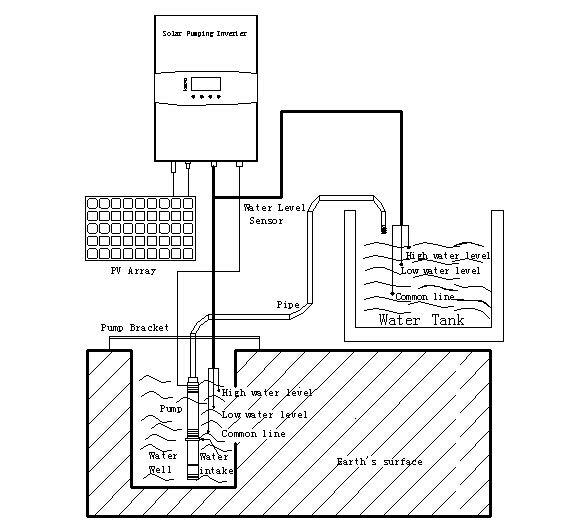

2.2 Application
Agricultural irrigation
Desert manage
Domestic water
Grassland animal husbandry
city waterscape
Island water supply
Landscape and fountain system of municipal engineering , city square , hotels and residence community
2.3 About product
This product is using a high performance digital signal processing chip, can provide solution for solar water pumpingsystem with high cost performance. Solar pumping system as a whole block diagram as shown in 2.
SHP series inverter has the following features:
a. True max power tracking technology (TMPPT) with our own intellectual property; effectively improve the use ratio of PV array. The stable tracking efficiency can reach 99.2% , Solving the problem of bad tracking efficiency and running unstability under the situation of sunlight intensity quick change when comparing with the traditional MPPT method .
b. Adopt efficient IPM power module from Mitsubishi Company with high reliability.
c. With the function of high and low water level detection , high safety factor.
d. Automatic anti-drying protection function , with multi-protection for motor
e. Multi-language LCD display , easy for operation , very user-friendly
f. The independent developed principal computer with our own intellectual properties , remote monitoring is available
g. Modular design , direct plug-in terminal , good-looking appearance, easy for installation , operation and maintenance .
h. Suitable for the pump adopted three phase asynchronous motor
i. Complete digital control , with the function of full automatic running and data storage .
j. Perfect protection system , with the protection function for lighting , over voltage , under voltage , short circuit , over loads , water drain off , low sunlight , over heating etc ,
k. Adopt the complete radiating system , so radiating efficiency is better and the service life is longer
l. Through strict environmental test , adapt the rigorous environment :-10℃~+50℃
m.No impacted mains supply power switch function (optional ), All-weather running available
n. Through strict environmental test , adapt the rigorous environment :-10℃~+50℃
FAQ
1. How fast will my system respond to a power outage?
Our solar inverters typically transfer to battery power in less than 16 milliseconds (less than 1/50th of a second).
2. What kind of batteries do the systems include?
Our solar backup electric systems use special high-quality electric storage batteries.
3. How do I install my system?
A solar backup inverter is connected to a home electric system , we will supply detailed installation manual and videos for our customers .

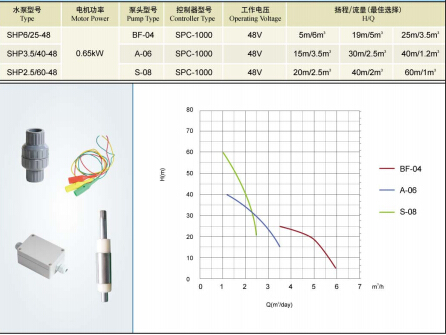

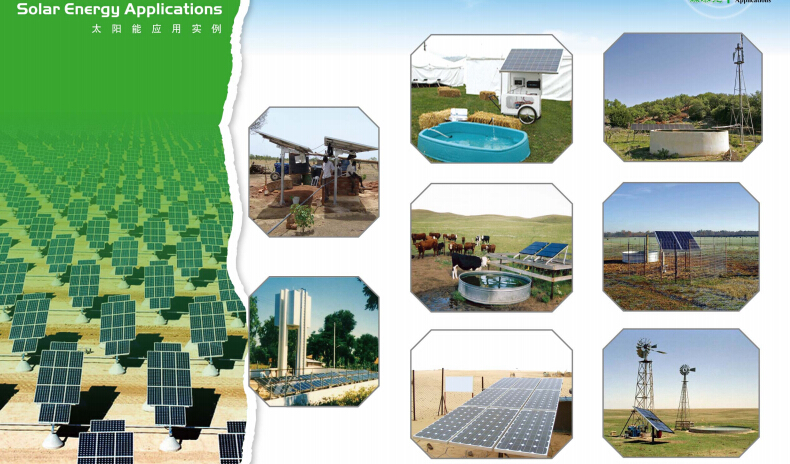




- Q: Can a solar pump be used in areas with high levels of chlorides in the water?
- Yes, a solar pump can be used in areas with high levels of chlorides in the water. Solar pumps are typically designed to handle various water conditions, including high chloride levels. However, it is important to ensure that the specific solar pump model chosen is suitable for such conditions and can withstand the corrosive effects of chlorides over time. Regular maintenance and proper system design may also be necessary to ensure optimal performance and longevity in these environments.
- Q: Can solar pumps be used in conjunction with other renewable energy sources?
- Yes, solar pumps can be used in conjunction with other renewable energy sources. By integrating solar pumps with sources like wind turbines or hydroelectric power, it is possible to create hybrid systems that maximize energy generation and ensure a reliable water supply. This combination of renewable energy sources enhances the overall efficiency and sustainability of the pumping system.
- Q: Are there any size restrictions for solar pumps?
- Solar pumps do not have specific size restrictions. Their size can vary depending on the application and requirements. There is a wide range of sizes and capacities available, from small pumps for residential or small-scale irrigation to large pumps for commercial or agricultural use. The size of the pump will be determined by factors such as the volume of water to be pumped, the distance it needs to travel, and the power generated by the solar panels. It is crucial to select a solar pump that is suitable for the intended use to guarantee optimal efficiency and performance.
- Q: Are there any government subsidies or incentives available for installing solar pumps?
- Yes, there are government subsidies and incentives available for installing solar pumps. Many governments around the world offer financial support, tax credits, or grants to encourage the adoption of solar energy technologies, including solar pumps. These incentives aim to promote sustainable and clean energy sources, reduce reliance on fossil fuels, and mitigate climate change. It is recommended to check with local government agencies or energy departments to learn about specific programs and eligibility criteria in your region.
- Q: Can a solar pump be used for water supply in remote research stations or observatories?
- Certainly, remote research stations or observatories can absolutely benefit from the use of a solar pump for water supply. These pumps are fueled by solar energy, meaning they don't rely on grid electricity or any sort of fuel for operation. As a result, they are an ideal option for locations that have limited or no access to electricity. Solar pumps are specifically designed to effectively extract water from wells, boreholes, or other water sources, and can serve various purposes such as drinking, irrigation, or supporting research-related activities. Moreover, solar pumps are not only easy to install and maintain but also boast significantly lower operating costs compared to traditional pumps powered by fuel. Given the ample sunlight typically available in most remote areas, a solar pump emerges as a sustainable and dependable solution for ensuring a consistent water supply in research stations or observatories.
- Q: How does the voltage and current output of the solar panel affect the performance of a solar pump?
- The performance of a solar pump is directly impacted by the voltage and current output of the solar panel. The voltage output of the solar panel determines the amount of electrical potential energy available for powering the pump. A higher voltage output enables the delivery of more energy to the pump, resulting in improved performance. Conversely, a lower voltage output restricts the available energy and can lead to reduced pump performance. The current output of the solar panel determines the rate at which energy is supplied to the pump. A higher current output ensures a greater flow of energy per unit of time, resulting in faster and more efficient pumping. Conversely, a lower current output diminishes the energy flow, leading to slower pumping and decreased performance. Matching the voltage and current output of the solar panel with the requirements of the solar pump is crucial. If the voltage or current output is too low, the pump may not operate optimally or may not function at all. Conversely, if the voltage or current output is too high, it can overload the pump or cause damage to its components. To summarize, the voltage and current output of a solar panel have a significant impact on the performance of a solar pump. Achieving the right balance of voltage and current output is essential for maximizing pump performance and ensuring the long-term viability of the system.
- Q: Are there any specific installation requirements for a solar pump system?
- Yes, there are specific installation requirements for a solar pump system. These requirements may vary depending on the specific type and size of the system, as well as the location and intended use. Firstly, it is important to ensure that the solar panels are installed in a location that receives sufficient sunlight throughout the day. Ideally, the panels should be installed on a roof or an area with unobstructed access to sunlight. Additionally, the panels should be positioned at an optimal angle to maximize solar energy absorption. Furthermore, the solar pump system should be installed in a location that is easily accessible for maintenance and repairs. This includes providing adequate clearance around the system and ensuring that there are no obstructions that could hinder access to the pump, controller, or other components. Another important requirement is the proper sizing and installation of the pump itself. This involves considering factors such as the required flow rate, pressure, and the specific application of the pump system. It is essential to select a pump that is suitable for the intended use and matches the system's requirements. Additionally, the system should be installed with the necessary safety precautions in mind. This includes grounding the system to protect against electrical shocks and ensuring that all electrical connections are properly insulated. It is also advisable to include a disconnect switch and surge protection devices to safeguard the system from power surges and other electrical issues. Lastly, it is crucial to follow any local building codes and regulations related to the installation of solar pump systems. This may include obtaining necessary permits and complying with specific guidelines set by local authorities. Overall, the installation of a solar pump system requires careful consideration of factors such as solar panel placement, pump sizing, safety measures, and compliance with local regulations. It is recommended to consult with a professional installer or seek guidance from reputable manufacturers to ensure a successful and efficient installation.
- Q: Are there any specific installation requirements for a solar pump system?
- A solar pump system has specific installation requirements that can vary depending on the system's type, size, location, and intended use. To begin, it is important to ensure that the solar panels receive sufficient sunlight throughout the day. Ideally, they should be installed on a roof or in an area with unobstructed access to sunlight. Moreover, the panels should be positioned at an optimal angle to maximize solar energy absorption. In addition, the system should be installed in a location that allows for easy maintenance and repairs. This involves providing enough clearance around the system and ensuring that there are no obstructions that could hinder access to the pump, controller, or other components. Another crucial requirement is the proper sizing and installation of the pump itself. This entails considering factors such as the required flow rate, pressure, and the specific application of the pump system. It is essential to choose a pump that is suitable for the intended use and meets the system's requirements. Moreover, the system should be installed with safety precautions in mind. This includes grounding the system to protect against electrical shocks and ensuring that all electrical connections are adequately insulated. It is also advisable to incorporate a disconnect switch and surge protection devices to safeguard the system from power surges and other electrical issues. Lastly, it is crucial to adhere to local building codes and regulations related to solar pump system installation. This may involve obtaining necessary permits and complying with specific guidelines established by local authorities. Overall, the installation of a solar pump system necessitates careful consideration of factors such as solar panel placement, pump sizing, safety measures, and compliance with local regulations. It is recommended to consult with a professional installer or seek guidance from reputable manufacturers to ensure a successful and efficient installation.
- Q: Can a solar pump be used for water supply in parks or recreational areas?
- Yes, a solar pump can be used for water supply in parks or recreational areas. Solar pumps are an efficient and sustainable solution for water supply in outdoor spaces. They harness solar energy to power the pump, eliminating the need for electricity and reducing costs. Additionally, solar pumps are environmentally friendly and can provide a reliable water source for various recreational purposes such as irrigation, decorative water features, and drinking water supply.
- Q: What is the maximum temperature a solar pump can handle?
- The maximum temperature that a solar pump can withstand may differ based on the specific model and manufacturer. Nevertheless, most solar pumps are generally built to endure temperatures ranging from 50-60 degrees Celsius (122-140 degrees Fahrenheit). To determine the exact maximum temperature rating for a particular solar pump model, it is crucial to consult the manufacturer's product specifications. Moreover, it is recommended to install the pump in a location that reduces exposure to extreme temperatures and guarantees sufficient ventilation for optimal performance and longevity.
Send your message to us
Outdoor Solar Water Pump - Centrifugal Pump System 0.65kW for Agricultural Irrigation
- Loading Port:
- Shanghai
- Payment Terms:
- TT OR LC
- Min Order Qty:
- 10 pc
- Supply Capability:
- 1000 pc/month
OKorder Service Pledge
OKorder Financial Service
Similar products
Hot products
Hot Searches
Related keywords
